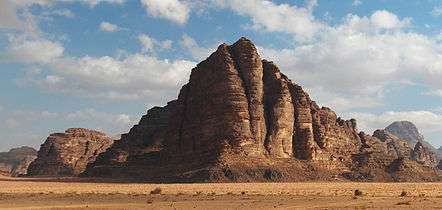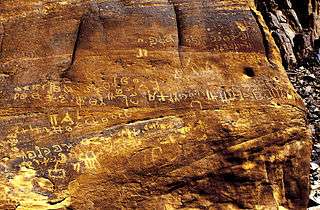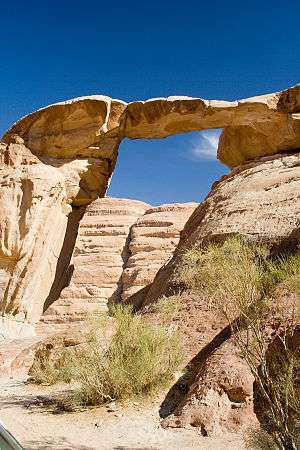Wadi Rum
| Wadi Rum (وادي رم) | |
| Valley of the Moon | |
| Protected Area | |
 Typical Wadi Rum vista | |
| Name origin: Possibly from Aramaic for "high valley" | |
| Country | Jordan |
|---|---|
| Governorate | Aqaba |
| Elevation | 1,750 m (5,741 ft) |
| Coordinates | JO 29°35′35″N 35°25′12″E / 29.59306°N 35.42000°ECoordinates: JO 29°35′35″N 35°25′12″E / 29.59306°N 35.42000°E |
| Area | 720 km2 (278 sq mi) |
| Biome | Desert |
| For public | Yes |
| Easiest access | From north |
| UNESCO World Heritage Site | |
| Name | Wadi Rum Protected Area |
| Year | 2011 (#35) |
| Number | 1377 |
| Region | Arab States |
| Criteria | i, iii, iv |
| IUCN category | Ia - Strict Nature Reserve |
 Location in Jordan | |
| Website: Wadi Rum | |
Wadi Rum (Arabic: وادي رم) also known as The Valley of the Moon (Arabic: وادي القمر) is a valley cut into the sandstone and granite rock in southern Jordan 60 km (37 mi) to the east of Aqaba; it is the largest wadi in Jordan.[1] The name Rum most likely comes from an Aramaic root meaning 'high' or 'elevated'.[2] To reflect its proper Arabic pronunciation, archaeologists transcribe it as Wadi Ramm.
History

Wadi Rum has been inhabited by many human cultures since prehistoric times, with many cultures–including the Nabateans–leaving their mark in the form of rock paintings, graffiti, and temples.
In the West, Wadi Rum may be best known for its connection with British officer T. E. Lawrence, who passed through several times during the Arab Revolt of 1917–18.[3] In the 1980s one of the rock formations in Wadi Rum was named "The Seven Pillars of Wisdom" after Lawrence's book penned in the aftermath of the war, though the 'Seven Pillars' referred to in the book have no connection with Rum.
Geography
The area is centered on the main valley of Wadi Rum. The highest elevation in Jordan is Jabal Umm ad Dami at 1,840 m (6,040 ft) high ( SRTM data says 1854 m), located 30 kilometres south of Wadi Rum village. It was first located by Difallah Ateeg, a Zalabia Bedouin from Rum. On a clear day, it is possible to see the Red Sea and the Saudi border from the top.
Jabal Ram or Jebel Rum (1,734 metres (5,689 ft) above sea level) is the second highest peak in Jordan and the highest peak in the central Rum,[4] rising directly above Rum valley, opposite Jebel um Ishrin, which is possibly one metre lower.
Khaz'ali Canyon in Wadi Rum is the site of petroglyphs etched into the cave walls depicting humans and antelopes dating back to the Thamudic times. The village of Wadi Rum itself consists of several hundred Bedouin inhabitants with their goat-hair tents and concrete houses and also their four-wheel vehicles, one school for boys and one for girls, a few shops, and the headquarters of the Desert Patrol.[5]
Recently, Geoff Lawton has achieved success in establishing a permaculture ecosystem in Wadi Rum.[6]
Tourism
Shots of Wadi Rum in Lawrence of Arabia kick-started Jordan's tourism industry.[7]
Wadi Rum is home to the Zalabia Bedouin who, working with climbers and trekkers, have made a success of developing eco-adventure tourism, now their main source of income. The area is now one of Jordan's important tourist destinations, and attracts an increasing number of foreign tourists, particularly trekkers and climbers, but also for camel and horse safari or simply day-trippers from Aqaba or Petra. In recent years, its luxury camping retreats have spurred more tourism to the area as well.[8] Popular activities in the desert environment include camping under the stars, riding Arab horses, hiking and rock-climbing among the massive rock formations. ATVs (All Terrain Vehicles) and Jeeps are also available and new camps have opened that offer adequate accommodation for tourists.
Dima and Lama Hattab coordinate an annual marathon in the region called Jabal Ishrin.
Rock climbing

The Bedouin have climbed in the Sandstone mountains of Wadi Rum for many generations. Many of their 'Bedouin Roads' have been rediscovered and documented by modern climbers. Several are included in the climbing guidebook by Tony Howard, and online by Liên and Gilles Rappeneau.[9]
In 1949 Sheikh Hamdan took surveyors to the summit of Jabal Ram. The first recorded European ascent of Jabal Ram took place in November 1952, by Charmian Longstaff and Sylvia Branford, guided by Sheik Hamdan. The first recorded rock climbs started in 1984, with the first of many visits by English climbers Howard, Baker, Taylor and Shaw. This group repeated many of the Bedouin routes, accompanied by locals and independently, including, in 1984, Hammad's Route on Jebel Rum, and, in 1985, Sheikh Kraim’s Hunter’s Slabs and Rijm Assaf on Jebel Rum.[10] Many new routes were climbed in the 1980s, by this team, French guide Wilfried Colonna, by the Swiss Remy brothers, and by Haupolter and Precht.[11] The first dedicated climbing guide book, Treks and Climb in Wadi Rum, by Tony Howard, was first published in 1987. Some of the many Bedouin routes have been documented online by Lien and Gilles Rappeneau.[12] A new routes book for climbers is held at the Wadi Rum Guest House.
The route Guerre Sainte was climbed in 2000 by Batoux, Petit and friends. This was the first route in Wadi Rum to be entirely equipped using bolt protection. The route, on the East Face of Jebel Nassarani North, is 450 m (1,480 ft) long, and graded F7b or F7aA0.[13]
Filming location
The area has been used as a background setting in a number of films. Filmmakers are particularly drawn to it for science fiction films set on Mars.[14]
- Lawrence of Arabia – David Lean filmed much of this 1962 film on location in Wadi Rum.[15]
- Red Planet – Wadi Rum was used as the surface of Mars in this 2000 film.
- Passion in the Desert – The area was also used for scenes in this 1998 film.
- The Face – BBC Film, Rock climbing in Rum, featuring Wadi Rum pioneers Tony Howard and Di Taylor.
- Transformers: Revenge of the Fallen – represented as being in Egypt
- The Frankincense Trail – scenes from train, and aerial filming too
- Prometheus – scenes for the Alien Planet[16]
- Krrish 3 – the song 'Dil Tu Hi Bata'
- May in the Summer – a film by Cherien Dabis presented at the 2013 Sundance Film Festival. Long shots of Wadi Rum set the mood for the film, it's a place where the main character finds peace away from the world and within herself.
- The Last Days on Mars – filming for exterior shots representing the surface of the titular planet for this 2013 film.[17][18]
- The Martian – filming for the Ridley Scott film began in March 2015, for shots that stood in for the surface of Mars.[19]
- Matt Damon on Wadi Rum:[20]
| “ | I was in awe of that place, it was really, really special. One of the most spectacular and beautiful places I have ever seen, and like nothing I’ve ever seen anywhere else on Earth. | ” |
Gallery
- Wadi Rum desert
- View from the top of Jabal Ram
 The "Seven Pillars of Wisdom" rock formation
The "Seven Pillars of Wisdom" rock formation Thamudic inscriptions in Wadi Rum
Thamudic inscriptions in Wadi Rum A sandstone formation carved by the elements in Wadi Rum
A sandstone formation carved by the elements in Wadi Rum- A Nabatean temple in Wadi Rum
 Jabal Umm Fruth Bridge is one of several natural arches in Wadi Rum
Jabal Umm Fruth Bridge is one of several natural arches in Wadi Rum- The Wadi Rum Visitor Center
 In 2011
In 2011 Mountain in Wadi Rum
Mountain in Wadi Rum
See also
References
- ↑ Mannheim, Ivan (1 December 2000). Jordan Handbook. Footprint Travel Guides. p. 293. ISBN 978-1-900949-69-9. Retrieved 30 May 2012.
- ↑ tours in Wadi Rum
- ↑ Ham, Anthony; Greenway, Paul (2003). Jordan. Lonely Planet. p. 212. ISBN 978-1-74059-165-2. Retrieved 30 May 2012.
- ↑ Scheck, Frank Rainer (1997). Jordanien: Völker und Kulturen zwischen Jordan und Rotem Meer (in German). DuMont Reiseverlag. p. 12. ISBN 978-3-7701-3979-8. Retrieved 30 May 2012.
- ↑ Howard, Tony; Taylor, Di (May 1997). Treks and Climbs in Wadi Rum, Jordan. Cicerone Press Limited. p. 20. ISBN 978-1-85284-254-3. Retrieved 30 May 2012.
- ↑ FROM DESERT TO OASIS IN 4 YEARS (JORDAN)
- ↑ The Complete Guide to Lawrence's Arabia
- ↑ Sweet, Joni. "Embrace Your Inner Jasmine Glamping at Wadi Rum". iExplore.com. Inside-Out Media. Retrieved 20 September 2016.
- ↑ Gilles, Rappeneau. "Les Voies Bedouin du Wadi Ramm". website. Retrieved 5 February 2014.
- ↑ Howard, Tony. "Climbing the Bedouin routes of Wadi Rum". Cicerone Extra. Cicerone Press 2016. Retrieved 26 March 2016.
- ↑ Howard, Tony (1987). Treks and Climbs in Wadi Rum. Milnthorpe, England: Cicerone Press. p. 192. ISBN 1 852841354.
- ↑ Rappeneau, Gilles. "Les Voies Bedouines des Wadi Ramm". Les Voies Bedouines des Wadi Ramm. Retrieved 26 March 2016.
- ↑ "The Guerre Sainte". CamptoCamp.org. Retrieved 17 September 2014.
- ↑ Stevens, Dana (October 1, 2015). "Saving Astronaut Watney". Slate. Retrieved October 2, 2015.
- ↑ "Touristic Sites – South of Amman". Kinghussein.gov.jo. Retrieved 30 May 2012.
- ↑ Galloway, Stephen (May 16, 2012). "Return of the 'Alien' Mind". The Hollywood Reporter. Retrieved August 22, 2015.
- ↑ Forde, Leon (2013-05-28). "Ruairi Robinson, The Last Days On Mars". Screen Daily. Retrieved 2015-02-09.
- ↑ Cooper, Sarah (2012-07-19). "Last Days On Mars". Screen Daily. Retrieved 2015-02-09.
- ↑ "Ridley Scott's The Martian moves to Jordan". kftv.com. January 27, 2015. Retrieved February 19, 2015.
- ↑ "Ridley Scott and Matt Damon on Going to Jordan to Recreate Mars". Yahoo!. Yahoo!. 2015-09-30. Retrieved 2015-10-08.
- ↑ Naji Abu Nowar talks about exploring the Bedouin way of life in his first feature Theeb
External links
| Wikimedia Commons has media related to Wadi Rum. |
| Wikivoyage has a travel guide for Wadi Rum. |